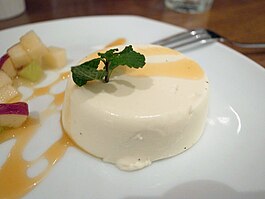Panna cotta
 Panna cotta with cream and garnish | |
| Type | Pudding |
|---|---|
| Place of origin | |
| Region or state | Piedmont |
| Main ingredients | Cream, sugar, gelatin |
| Variations | various flavorings |
Panna cotta (Italian 'cooked cream') is an Italian dessert of sweetened cream thickened with gelatin and molded. The cream may be aromatized with rum, coffee, vanilla, or other flavorings.
Preparation
Sugar is dissolved in warm cream. The cream may be flavored, either by infusing spices and the like in it, or by adding rum, coffee, vanilla, and so on. Gelatin[1] is softened in a cold liquid, then added to warm cream mixture. This is poured into molds and allowed to set.[2] The molds may have caramel in the bottoms, giving a result similar to a crème caramel.[3]
Although the name means 'cooked cream', the ingredients are only warmed enough to dissolve the gelatin and sugar.[4]
Garnishes
Panna cotta is often served with a coulis of berries, or a sauce of caramel or chocolate. It may be covered with fruit or with liqueurs.[2]
History
The name panna cotta is not mentioned in Italian cookbooks before the 1960s,[4][2] yet it is often cited as a traditional dessert of the northern Italian region of Piedmont. One (undocumented) story says that it was invented by a Hungarian woman in the Langhe in the early 1900s.[5] An 1879 dictionary mentions a dish called latte inglese 'English milk', made of cream cooked with gelatin and molded,[6] though other sources say that latte inglese is made with egg yolks;[7] perhaps the name covered any thickened custard-like preparation.
The Region of Piedmont includes panna cotta in its 2001 list of traditional food products of the region.[8] Its recipe includes cream, milk, sugar, vanilla, gelatin, rum, and marsala poured into a mold with caramel.[9] Another author considers the traditional flavoring to be peach eau-de-vie, and the traditional presentation not to have sauce or other garnishes.[10]
Panna cotta became fashionable in the United States in the 1990s.[11][12]
-
A close-up view of fennel panna cotta
Related dishes
Bavarian cream is very similar to panna cotta, made of milk and cream thickened with gelatin or isinglass, though the flavorings and garnishes are generally different.
Blancmange is sometimes thickened with gelatin or isinglass, sometimes with starch.
Custard, on the other hand, is generally thickened with egg yolks, though in Britain, it may be thickened with cornflour; see custard powder.
See also
References
- ^ in Italian, gelatin is often called colla di pesce (literally, 'fish glue', i.e. isinglass); it is unclear whether true isinglass was ever used
- ^ a b c Luigi Carnacina, Luigi Veronelli, "Panna Cotta", La Cucina Rustica Regionale 1:156, 1977, based on La Buona Vera Cucina Italiana (not seen), 1966
- ^ Accademia Italiana della Cucina, La Cucina: The Regional Cooking of Italy, ISBN 978-0-8478-3147-0, p. 832, 2009, translation of La Cucina del Bel Paese
- ^ a b Camilla V. Saulsbury, Panna Cotta: Italy's Elegant Custard Made Easy, p. 14
- ^ Davidson, Alan (2006). Jaine, Tom (ed.). The Oxford Companion to Food (second ed.). Oxford: Oxford University Press. p. 574. ISBN 9780192806819.
{{cite book}}:|access-date=requires|url=(help) - ^ P. Fornari, Il nuovo Carena : la casa, o Vocabolario metodico domestico : compilato sui più recenti lavori di lingua parlata, con raffronti dei principali dialetti : ad uso delle scuole, 1879, p. 498
- ^ Pietro Fanfani, Vocabolario della lingua italiana: per uso delle scuole, 2nda edizione, 1865, p. 848
- ^ Riccardo Brocardo, "I prodotti agroalimentari tradizionali del Piemonte a quota 370", full text
- ^ "Prodotto n. 69", Bollettino Ufficiale Regione Piemonte 33:23 (supplement) p. 532
- ^ Anna Del Conte, Gastronomy of Italy (revised edition), 2013, ISBN 1862059586, s.v.
- ^ Amanda Hesser, The Essential New York Times Cookbook: Classic Recipes for a New Century, p. 441: "1990's: ... Panna Cotta replaces crème brûlée, excising the egg yolks and using gelatin for a wobbly texture"
- ^ Greg Atkinson, West Coast Cooking, 2006, ISBN 1570614725, s.v. 'panna cotta': "panna cotta took us by storm in the '90s"

